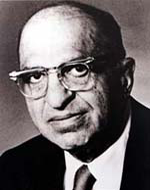Julius Shiskin (October 13, 1912 – October 28, 1978) was an American economist.[1] He is known for his contributions to establishing rules in the field of economic statistics. His 1974 unofficial rule-of-thumb definition of a recession continues to be considered by many as the official definition.[2] He authored two books and numerous articles in the field of statistics,[3] and served as the ninth U.S. Commissioner of the Bureau of Labor Statistics from 1973 until his death.[4]

Family and education
editShiskin was born in New York on October 13, 1912, and completed his primary education in New Jersey[5] where he graduated from Rutgers University.[5] He was married to Frances Levine and they had two daughters, Laura and Carol.[3][5]
Career
editShiskin taught economics and statistics at the Rutgers university between the years of 1934 and 1938. From 1938 through 1942, he worked as a staff assistant for the National Bureau of Economic Research,[4] and from 1942 to 1945 he was the chief economist for the War Production Board.[6]
In 1945 he joined the Census Bureau, where he held positions of Chief of the Economic Research and Analysis Division and assistant director for Program Planning and Evaluation at the Census Bureau. He played a crucial role in the creation of a computerised technique for seasonally adjusting economic time series and was a significant contributor to the advancement of the business-cycle statistics program. Shiskin joined the Office of Management and Budget in 1969 and assumed the role of Commissioner of Labour Statistics in 1973.[6] While he was in this post, the United States experienced the most severe economic downturn since the Great Depression.[3] Shiskin died on October 28, 1978.[7]
Recession definition
editIn a 1974 New York Times opinion piece about recessions, Shiskin wrote:[8]
The [Bureau of Labor Statistics]'s definition of a recession is, however, known to only a small number of specialists in business cycle studies. Many people use a much simpler definition—a two‐quarter decline in real [GDP]. While this definition is simplistic, it has worked quite well in the past.
Many have since maintained that this two-quarter rule-of-thumb is the official definition of a recession in the United States. Since 1978, however, the Business Cycle Dating Committee of the National Bureau of Economic Research has "called" recession starts and ends, which it defines as "a significant decline in economic activity that is spread across the economy and that lasts more than a few months" and involves examination of the depth, diffusion, and duration of the decline.[9][10]
Memorial Award for Economic Statistics
editThe annual Julius Shiskin Award for Outstanding Achievement in Economic Statistics is sponsored by the Washington Statistical Society, American Statistical Association, and National Association of Business Economists.[6]
References
edit- ^ Means, United States Congress House Committee on Ways and (1966). Legislative History of H.R. 17607, 89th Congress: Suspension of the Investment Credit and the Allowance of Accelerated Depreciation in the Case of Certain Real Property, Public Law 89-800. Eighty-ninth Congress, Second Session. U.S. Government Printing Office. p. 1354.
- ^ "The risk of redefining recession - May. 6, 2008". money.cnn.com. Retrieved June 28, 2023.
- ^ a b c Nomination - First session on Julius Shiskin, of Maryland, to be commissioner of labor statistics, department of labor (PDF) (Report). Hearing before the Committee on Human Resources United States Senate. October 6, 1977.
- ^ a b Monthly Labor Review. U.S. Government Printing Office. 1978. p. 2.
- ^ a b c Agencies, United States Congress House Committee on Appropriations Subcommittee on Departments of Labor, and Health, Education, and Welfare, and Related (1976). Departments of Labor and Health, Education, and Welfare Appropriations for 1977: Department of Labor related agencies. U.S. Government Printing Office. p. 632.
{{cite book}}: CS1 maint: multiple names: authors list (link) - ^ a b c US Census Bureau, Census History Staff. "Julius Shiskin - History - U.S. Census Bureau". www.census.gov. Retrieved June 28, 2023.
- ^ Norwood, Janet L. (1979). "In Memoriam: Julius Shiskin 1912–1978". The American Statistician. 33 (3): 137. doi:10.1080/00031305.1979.10482679. Retrieved July 23, 2023.
- ^ Shiskin, Julius (December 1, 1974). "The Changing Business Cycle". The New York Times. p. 222. ISSN 0362-4331. Retrieved June 28, 2023.
- ^ "Recession referees". National Public Radio. June 24, 2022.
- ^ "Business Cycle Dating Procedure: Frequently Asked Questions". National Bureau of Economic Research.